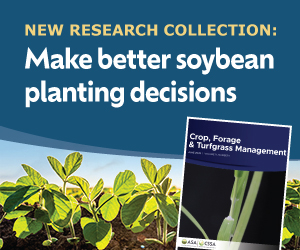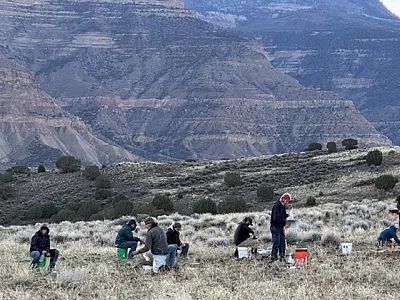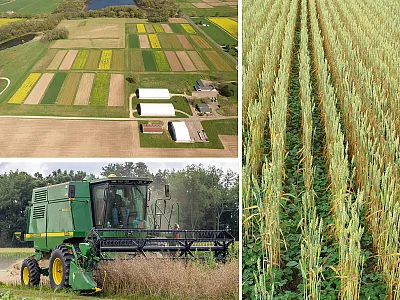Optimizing Agronomy for High-Yielding Flax in Western Canada
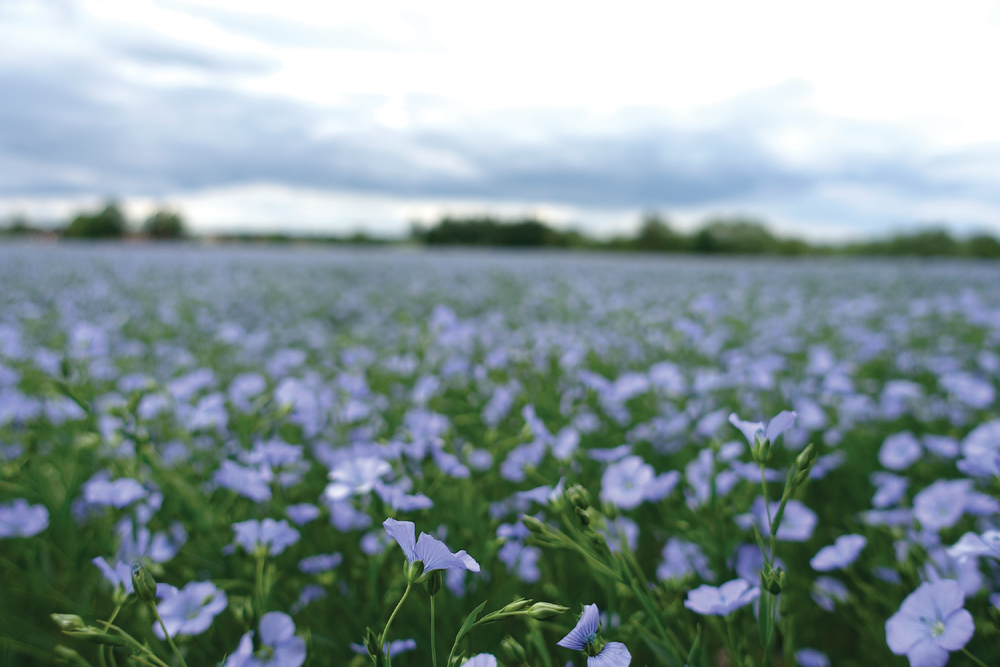

Flax is an important oilseed crop of temperate regions, and Canada been the world’s top
exporter of the crop since 1994. Increasing crop yields either through breeding or better agronomy can substantially benefit the flax industry in Canada. A multi-location study was carried out in western Canada to determine the optimum combination of several agronomic practices to obtain high and stable flax yields. Earn 0.5 CEUs in Crop Management by reading this article and taking the quiz at https://web.
sciencesocieties.org/Learning-Center/Courses.
Flax is an important oilseed crop of temperate regions cultivated for many purposes such as vegetable oil, dietary supplements, industry uses (paint and fiber), biodiesel fuel, etc. Canada has been within the top three global producers with around 40% production share and has been the world’s top exporter since 1994 (Flax Council of Canada, 2019). Canada produced 456,000 metric tonnes of flax in 2022 (Statistics Canada, 2022), and during the last five years, flax was cultivated in the range of 340,000 to 410,000 acres (Statista, 2021). The majority of flax in North America is used as feed, but in Asia, it is used as food. However, due to uncovering of its nutritional benefits, particularly its functional properties such as high protein (22%) and oil containing α‐linolenic acid, as well as a soluble polysaccharide mucilage (Marambe & Wanasundara, 2017), its use in the bakery industry and pet food industry is growing in Canada.
Flax is an annual herbaceous plant with a shallow taproot system (90–120 cm). The cultivars primarily grown for food are short in stature and have many secondary branches and seed balls per plant. The cultivars grown for fiber have tall, straight culms and few secondary branches. In North America, flax is mainly grown in the Brown, Dark Brown, Black, and Dark Gray Chernozemic soils of the Canadian Prairies and the southern extensions of these soil zones in the states of North Dakota, South Dakota, and Montana. Two types of flax, brown and yellow (solin flax), are cultivated in North America. Solin flax is enriched in linoleic acid and low in α‐linolenic acid and found to be an alternative to sunflower and safflower seed oils (Vrinten et al., 2005). Flax is grown best in moist, warm climates with frost‐free late spring conditions. High temperatures in the absence of drought can decrease seed set and yield (Cross et al., 2003).
Flax production was in a declining trend or stagnated due to many reasons, including low yield potential compared with canola (Canada’s largest oilseed crop) and low yield stability. However, the encouraging fact about flax is its high gross return (probably due to low input cost and moderate prices), which is comparable to canola (May et al., 2010). Therefore, increasing crop yields either through breeding or better agronomy can substantially benefit the flax industry in Canada. Obtaining optimal plant stand and plant spatial arrangement can be some of the basic requirements for obtaining high yields in many crops including flax. Seeding density and row spacing collectively determine optimum solar radiation interception, and together with optimum nutrient supply, these factors can produce optimum crop yields. According to the Flax Council of Canada (2019), the optimal plant density for flax could be 300 to 400 plants/m2 (28 to 37 plants/ft2), which can be achieved with a 31 to 40 lb/ac seeding rate. Further increase in seeding rates was found to have limited but mixed results from various past studies depending on the conditions (Kurtenbach et al., 2019; Lafond et al., 2008; Stevenson & Wright, 1996). Increasing the seeding rate can be beneficial to achieve early maturity and can be essential as desiccants are not recommended in flax in compliance with market requirements. Several studies have found that increasing the row spacing above 10 inches (25 cm) did not have many benefits (Lafond, 1993; IHARF, 2016). On the other hand, wide row spacing can reduce disease incidence due to reduced relative humidity within the canopy. Further, wide row spacing in no‐till systems can benefit seeding operations in high‐crop‐residue conditions by lowering the cost of seeding and by reducing soil disturbance.
Other than finding the optimal balance of crop density and spatial arrangement, finding the right balance for nutrients, particularly N, can be important to boost flax yield. Past studies found that the response of flax yield to increases in N is fairly low; however, recent studies are showing some yield responses. Combining these three factors (seeding rate, row spacing, and N fertilizer rate) can improve crop yields, but achieving the right balance is critical. An imbalance (combination of high N, high crop density, and narrow row spacing) could increase diseases such as pasmo. Pasmo is a seed‐borne fungal disease caused by Septoria linicola (Speg). It is one of North America’s most abundant flax diseases (Rashid et al., 2013). Fungicide application was found to be the main tool for managing this disease; thus, fungicide application is critical when using any combination of high N rates, high‐density planting, and narrow crop row spacing. These four factors can interactively or additively determine flax crop yields and further can be influenced by growing conditions. Some scientific investigation is required to understand flax yield and stability under these diverse agronomic practices and under diverse growing conditions. Therefore, a multi‐location study was carried out in western Canada to determine the optimum combination of several agronomic practices to obtain high and stable flax yields.
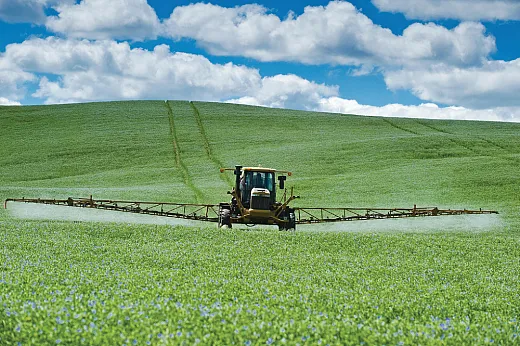
Experiment Layout
Field experiments were conducted at the Kernen Research Farm Saskatoon, SK on a Black Chernozemic loam (pH 7.7, organic matter 2.9%); Goodale Research Farm Saskatoon, SK on a Dark Brown Chernozem (pH 7.0, organic matter 1.9%); and at Carman, MB on a Gleyed Black Chernozem (pH 5.5, organic matter 6%). The experiment was conducted from 2015 to 2018 at Kernen, 2015 and 2016 at Carman, and 2018 at Goodale. The experiment had four treatments with two levels in each giving 16 treatment combinations (see Table 1). The four treatments were (1) seeding density (target density of 450 and 900 seeds/m2 or 42 and 84 plants/ft2), (2) row spacing (7.8 inches and 15.6 inches), (3) nitrogen fertilizer rate (65 and 130% of soil test recommendation for a yield target of 35 bu/ac [flax bushel weight = 56 lb/bu]), and (4) fungicide application (pyraclostrobin + fluxapyroxad application, no fungicide application). Flax (cultivar CDC Glas) was direct‐seeded into standing wheat stubble using a plot seeder equipped with hoe openers at Kernen and Goodale and a double disk opener at Carman.
| Treatment Number | Treatment | Yield (bu/ac) | CVb |
|---|---|---|---|
| 14 | MD-NR-HN-F | 23.6a | 48.8(5) |
| 6 | LD-NR-HN-F | 23.2ab | 47.7(4) |
| 2 | LD-NR-LN-F | 22.8abc | 49(7) |
| 16 | MD-WR-HN-F | 22.6abcd | 43.2(1) |
| 10 | MD-NR-LN-F | 22.4abcd | 54.2(8) |
| 8 | LD-WR-HN-F | 22.2abcde | 44.9(2) |
| 12 | MD-WR-LN-F | 22.2abcde | 49(6) |
| 13 | MD-NR-HN-NF | 21.2abcde | 61.5(12) |
| 9 | MD-NR-LN-NF | 20.9abcde | 65.7(15) |
| 1 | LD-NR-LN-NF | 20.5bcde | 59.7(10) |
| 3 | LD-WR-LN-NF | 20.2de | 56.1(9) |
| 5 | LD-NR-HN-NF | 20.0cde | 66.5(16) |
| 4 | LD-WR-LN-F | 19.9de | 46.4(3) |
| 15 | MD-WR-HN-NF | 19.8de | 61.9(13) |
| 7 | LD-WR-HN-NF | 19.3de | 61.2(11) |
| 11 | MD-WR-LN-NF | 19.1de | 65.3(14) |
aMD, moderate density; LD, low density; NR, narrow row spacing; WR, wide row spacing; HN, 130% N; LN, 65% N; F, fungicide applied; NF, no fungicide applied.
bCV, coefficient of variation.
Environmental Conditions
In general, growing degree day period was in the range of 1,600–1,700 (2015–2018) for Saskatoon, SK locations and 1,400–1,500 (2015–2016) for Winnipeg, MB locations. Precipitation from May through September was variable, depending on the site‐year (Table 2). In both years, Carman received greater precipitation than the two other sites and was greater than the total long‐term precipitation. Kernen received precipitation that was above the long‐term average in 2015 and 2016 but low in 2017 and 2018. Goodale 2018 received the lowest precipitation and represents the driest environment of all site‐years.
| Location | Year | May | June | July | August | September | Avg./total |
|---|---|---|---|---|---|---|---|
| Precipitation (inches) | |||||||
| Kernen | 2015 | 0.24 | 0.79 | 0.59 | 2.29 | 2.0 | 8.66 |
| 2016 | 1.63 | 1.95 | 2.3 | 2.76 | 0.94 | 9.60 | |
| 2017 | 2.4 | 1.61 | 1.16 | 1.22 | 1.45 | 7.87 | |
| 2018 | 1.49 | 0.05 | 2.18 | 1.109 | 1.69 | 6.53 | |
| Long terma | 1.43 | 2.54 | 2.11 | 1.74 | 1.5 | 9.3 | |
| Carman | 2015 | 3.88 | 2.96 | 4.3 | 1.86 | 1.65 | 14.6 |
| 2016 | 4.2 | 3.75 | 3.0 | 2.27 | 2.54 | 15.9 | |
| Long terma | 2.74 | 3.79 | 3.09 | 2.94 | 1.92 | 14.5 | |
| Goodale | 2018 | 1.29 | 1.1 | 1.57 | 1.49 | 0.62 | 6.1 |
| Long terma | 1.35 | 2.49 | 2.12 | 1.73 | 1.5 | 9.2 | |
aLong-term normal (1981 to 2010). See http://climate.weather.gc.ca/historical_data/search_historic_data_e.html.
Crop Emergence, Disease Suppression, and Crop Yield
Plant density varied considerably among the different environments. At low seeding density (LD), the actual plant density achieved was in the range of 154–450 plants/m2 (14 to 42 plants/ft2), and it was in the range of 110–787 plants/m2 (10 to 73 plants/ft2) for the high seeding density (HD). Carman 2015 was the only site‐year with the closest to the targeted planting densities with 451 at LD and 787 plants/m2 (42 to 73 plants/ft2) at HD. Overall, increasing the seeding density by 100% increased actual plant density only by 68%. The mean plant density (at all site‐years) under the HD (900 seeds/m2 or 84 seeds/ft2) treatment was only 320 plants/m2 (30 plants/ft2) while it was 190 plants/m2 (18 plant/ft2) for the LD (450 seeds/m2 or 42 seeds/ft2) treatment. Since the HD of this study was unable to achieve beyond the recommended 400 plants/m2 (37 plants/ft2) (Flax Council of Canada, 2019), it was considered a moderate density (MD). This study also supports previous studies that flax has a poor emergence response to increasing seeding rates (Lafond, 1993).
Fungicide application reduced the pasmo rating slightly, irrespective of all other treatments across all environments. However, none of the individual crop management practices examined in this study had a significant effect on flax seed yield. Increasing the seeding density and reducing the row spacing have been identified as key strategies to increase crop yield in many field crops. The lack of seeding density effect was likely due to the moderate crop density identified (322 plants/m2 or 30 plants/ft2) even with high targeted seeding density (900 plants/m2 or 83 plants/ft2). There was a four‐way interaction identified for crop yield, indicating that none of the changes in agronomic factors had an individual direct effect on final crop yield irrespective of other factors. Average among all the environments, the combination of moderate density (MD), narrow row spacing (NR), 130% N (HN), and fungicide application (FA) showed a 23% mean yield increase compared with the lowest‐yielding combination, which was moderate density, wide‐row spacing, 65% N, and no fungicide application. However, the high‐yielding combination did not have a high yield in all environments and was found to vary, depending on the environmental conditions. Differences in weather conditions and plant emergence might have driven these site‐specific effects of the different treatment combinations. The most common factor determined to be influencing crop yield under all environmental conditions was the application of fungicides (Table 1). This was found to be interesting as we did not observe high pasmo disease incidence in most environments and the yield benefit of fungicide application may not necessarily be due to disease suppression. There was some scientific evidence that the fungicide used in this study caused direct yield benefits other than disease suppression.
Stability of Crop Yields
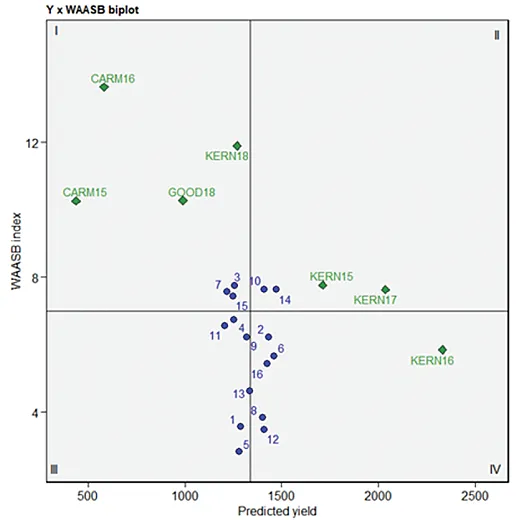
Stability analysis was carried out to understand the four‐way interaction and how it varies among the seven site‐years of the study. This enabled us to determine which treatment combination is consistently high yielding under varying environmental conditions and which one is most low yielding under many conditions. Among the seven site‐years (seven environments), Carman 2015, Carman 2016, Goodale 2018, and Kernen 2018 were identified as unfavorable environments with seed yields of 6.9, 9.2, 15.7, and 20.2 bu/ac, respectively. The favorable environments were Kernen 2015–2017 with mean yields of 27.2, 37.0, and 32.3 bu/ac, respectively (Figure 1). The combination of moderate density, wide‐row spacing, 130% N, and fungicide application (MD‐WR‐HN‐FA) had overall high yields and also showed the lowest variability among all treatments based on yield stability indicators. Further, it was grouped in Zone IV of the yield stability diagram (Figure 1), meaning high yield and high stability. The highest‐yielding treatment averaged across all environments (MD‐NR‐HN‐FA) also had a high rank under favorable environments but did not rank highly under overall environmental conditions, and it was grouped in Zone I (Figure 1). Some other treatment combinations such as LD–NR–LN–FA, LD–NR–HN–FA, and MD–WR–HN–FA (Treatments 2, 6, and 16; see Table 1 for abbreviations) were also located in Zone IV (high yield and high stability zone), indicating high productivity and stability. The two low‐yielding combinations (LD‐WR‐HN‐NFA and MD‐WR‐LN‐NFA) were found to have low stability as they appeared in Zone I of the yield‐stability joint plot (Figure 1).
Conclusions
Flax response to different agronomic practices was highly variable, depending on the environmental conditions. Across all treatment combinations, the high N treatment and fungicide application were the common factors underlying both stability and productivity. However, seeding density and row spacing effects varied under different environmental conditions. The optimum combination with moderate density, narrow row spacing, high N fertilizer, and fungicide application had high mean yields but was not productive under low‐yielding environments. Thus, this study confirms that in most favorable growing conditions, increasing the seeding rate and reducing row spacing can provide a yield benefit, but it has to be supplemented with an increase in N and the application of fungicides.
References
Cross, R.H., Mckay, S.A.B., McHughen, A.G., & Bonham‐Smith, P.C. (2003). Heat stress effects on reproduction and seed set in Linum usitatissimum L. (flax). Plant, Cell & Environment, 26, 1013–1020.
Culbertson, J.O. (1954). Breeding flax. Advances in Agronomy, 6, 174–178.
Flax Council of Canada. (2019). Growing flax production management and diagnostic guide. Saskatchewan Flax Development Commission.
Indian Head Agricultural Research Foundation (IHARF). (2016). Indian Head Agricultural Research Foundation Annual Report 2018. IHARF.
Kurtenbach, M.E., Johnson, E.N., Gulden, R.H., Duguid, S., Dyck, M.F., & Willenborg, C. J. (2019). Integrating cultural practices with herbicides augments weed management in flax. Agronomy Journal, 111(4), 1904–1912.
Lafond, G., Irvine, B., Johnston, A.M., May, W.E., McAndrew, D.W., Shirtliffe, S.J., & Stevenson, F.C. (2008). Impact of agronomic factors on seed yield formation and quality in flax. Canadian Journal of Plant Science, 88, 485–500.
Lafond, G.P. (1993). The effects of nitrogen, row spacing and seeding rate on the yield of flax under a zero‐till production system. Canadian Journal of Plant Science, 73(2), 375–382.
Marambe, H.K., & Wanasundara, J.P.D. (2017). Protein from flaxseed (Linum usitatissimum L.). In J. Sudarshan Nadathur & L.S. Wanasundara (Eds.), Sustainable protein sources (pp. 133–144). Academic Press.
May, W.E., Brandt, S.A., Gan, Y., Kutcher, H.R., Holzapfel, C.B., & Lafond, G.P. (2010). Adaptation of oilseed crops across Saskatchewan. Canadian Journal of Plant Science, 90(5), 667–677.
Rashid, K.Y., Desjardins, M.L., & Duguid, S. (2013). Diseases of flax in Manitoba and Saskatchewan in 2012. Canadian Plant Disease Survey, 93, 161–162.
Stevenson, F.C., & Wright, A.T. (1996). Seeding rate and row spacing affect flax yields and weed interference. Canadian Journal of Plant Science, 76, 537–544.
Statista. (2017). Area of flaxseed harvested in Canada from 2008 to 2021. https://www.statista.com/statistics/454274/area‐of‐flaxseed‐harvested‐in‐canada/
Statistics Canada. (2022). Agriculture and food statistics. Statistics Canada. https://www.statcan.gc.ca/en/subjects‐start/agriculture_and_food
Vrinten, P., Hu, Z., Munchinsky, M.A., Rowland, G., & Qiu, X. (2005). Two FAD3 desaturase genes control the level of linolenic acid in flax seed. Plant Physiology, 139, 79–87.
Self-Study CEU Quiz
Earn 0.5 CEUs in Crop Management by taking the quiz for the article at https://web.sciencesocieties.org/Learning-Center/Courses. For your convenience, the quiz is printed below. The CEU can be purchased individually, or you can access as part of your Online Classroom Subscription.
- The flax cultivars primarily grown for food
- have few secondary branches.
- are short in stature.
- have tall, straight culms.
- have few seed balls per plant.
- Flax is grown best in cool, dry climates.
- True.
- False.
- In Canada, compared with canola, flax has
- high yield potential.
- high yield stability.
- comparable yield potential.
- comparable gross return.
- What seeding rate range will get you the optimal flax planting density in Canada?
- 17 to 26 lb/ac.
- 28 to 33 lb/ac.
- 31 to 40 lb/ac.
- 52 to 55 lb/ac.
- This study confirms that in most favorable growing conditions, a yield benefit for flax can be achieved by
- increasing the seeding rate and decreasing N.
- increasing seeding rate, reducing row spacing, increasing N, and applying fungicides.
- increasing row spacing and an increasing P.
- increasing row spacing, decreasing P, and employing no-tillage.
Text © . The authors. CC BY-NC-ND 4.0. Except where otherwise noted, images are subject to copyright. Any reuse without express permission from the copyright owner is prohibited.



